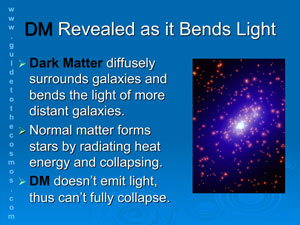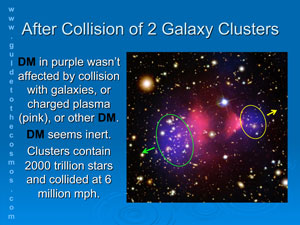|
|

|
Normal matter has only 4.5% of the total energy in
our universe; Dark Matter (“DM”) amounts to 22.5%. DM doesn’t emit or
absorb light, but we detect it as its enormous gravity bends the light
from more distant stars and galaxies. The degree of light bending tells
us where and now much DM is present, shown in purple.
|
|
The
“Bullet Cluster” shows the aftermath of a collision of two galaxy
clusters that are circled in the image. The purple Dark Matter (“DM”)
appears unaffected by its passage through galaxies, ionized gas (plasma
shown in pink), and even other DM.
|

|
|

|
Since all
galaxies gravitationally pull on one another, the expansion
rate should slow down over time. Indeed, these data show the rate was
higher long ago (to the right) and dropped to a minimum 6 billion years
ago. However, the rate has increased; the expansion is now
accelerating. This surprise is
attributed to Dark Energy.
|
|
Dark
Energy is most likely the effect of virtual particles predicted by
Quantum Mechanics. If so, space has positive energy and negative
pressure, leading to negative gravity — it pushes everything apart.
When the universe began (left side), the amount of space was small and
the attractive gravity of matter dominated. As space expanded, the
density of matter dropped.
|
 |
|
|